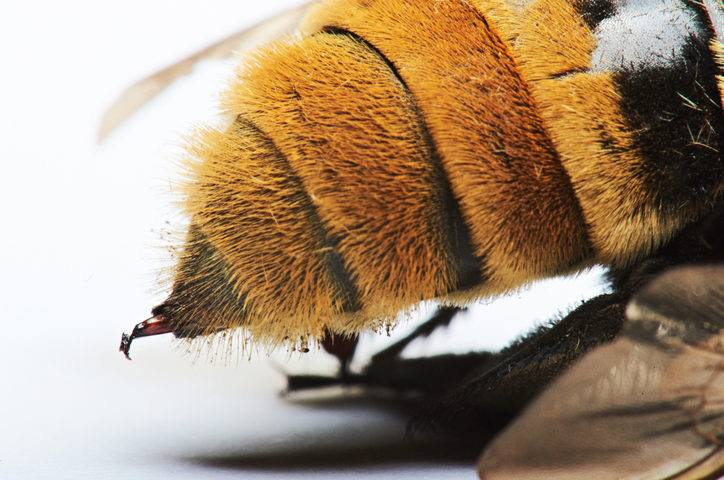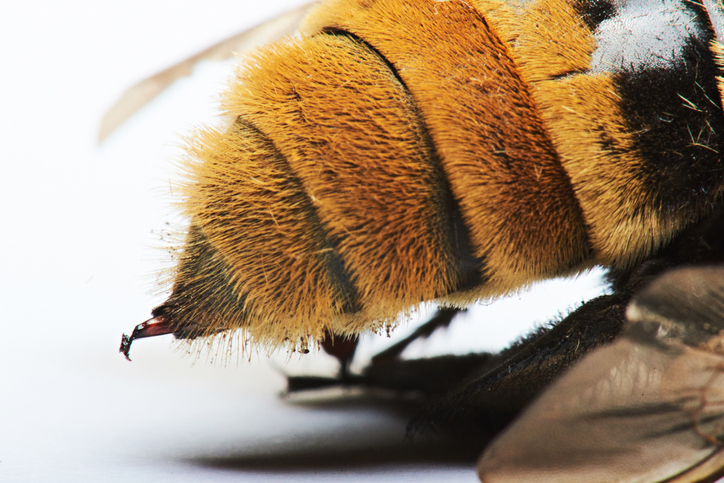- All-In-One Beekeeping for the Bees
- +1-608-728-8233
- info@beepods.com
Let’s Dispel Those Misconceptions About Bees

Macro of bumblebee sting

Bee with stinger
While developing a fear of bees is understandable, especially if you have a bee allergy or vividly remember your first bee sting, there are many misconceptions about bees that keep people from understanding these amazing insects. When people don’t understand bees, they are less willing to support bees.
It’s common to be afraid of bees. In fact, there’s a name for it: melissophobia (sorry to the Melissas out there.) Most people have at least one unpleasant memory of sustaining a bee sting. I myself have a not-so-fond memory of being stung right on the behind as I played by our pool and the Benadryl haze that soon followed.
As we go deeper into the spookiest month of the year, it’s a good time to dispel common misconceptions about bees so we can all be a little less afraid.
All bees sting
There’s 20,000 some species of bees and this may come as a shock to you, but not all of them sting. Moreover, it’s typically the females of any given bee species that have the capability to sting; the sting is a modified body part for laying eggs. It’s important to keep in mind, bees typically only sting if they feel threatened, not just indiscriminately or because you’re near them.
There’s actually a misconception within this misconception that bees don’t sting at night. This is false; if a bee feels threatened at night, a bee will still sting.
All bees produce honey
Most bee species do not produce honey, at least not in a quantity that is worth harvesting. In fact, less than 5% of bee species produce any honey at all. You may be interested to know bumblebees are part of that 5%, but it’s in such a small quantity, it’s barely noticeable (one to two teaspoons per hive.) Stingless bees and honeybees are the species that produce significant amounts of honey.
All bees work hard
You’ve heard it before. “Busy as a bee.” It’s not entirely true. While the worker bees do keep relatively busy engaging in tasks like foraging, rearing the young, and helping out the queen, drones are somewhat lazy by comparison.
Worker bees have a lengthy list of responsibilities in and around the hive and the drones have one: reproduction. It might be more accurate to say, “Busy as a worker bee.”
Wasps and yellow jackets are types of bees
Thank heavens, no. While we may all differ in our political opinions and lifestyle choices, I think we can agree that wasps and yellow jackets kind of suck.
Wasps are a category unto themselves and yellow jackets are technically a type of wasp. Despite looking somewhat similar to bees, these insects behave very differently. For example, yellow jackets are cannibalistic and often eat bees, which they macerate into a protein-filled paste, regurgitated to feed their young.
I know, nature is a scary place sometimes.
We can be reassured that bees are essentially vegetarians and forage on pollen, nectar, and resin from plants.
All bees live in hives

Yellow jacket wasps leaving the nest. The wasp nest is located in the ground, along the Avon River in Stratford, Ontario.
About 10% of bee species are social, meaning they live together in well-organized groups. Honeybees, for example, are considered a social species of bees. Bee species that are not socially oriented in hives tend to tunnel in the ground or take up residence in fallen logs.
If you want to support wild bee populations, it’s important to leave areas of your yard free from mulch to support their tunneling behavior. If you have old logs laying around, maybe just leave them as they are, but keep in mind the logs may not remain vacant for long.
Sealing up a hole where bees are nesting will kill them
No. This will just make them mad and we’ve already talked about angry bees (hint: this is when they tend to sting.)
You can avoid bee stings by spraying the nest with water
Do you like being sprayed in the face with water? Would it, perhaps, make you a little angry? Here’s your friendly reminder: bees that feel threatened tend to get angry and angry bees might sting you.
Do not spray nests with water.
It’s really best you avoid doing things that might aggravate bees and keep a healthy distance between you and the hive if you’re unsure of how to behave.
Bees are the only pollinators
Bees get a lot of attention in the news, but there are many misconceptions about bees when it comes to the topic of pollination. I have some bad news. Remember how we talked about how much yellow jackets and wasps suck? They are actually pollinators, just like bees.
Fun fact: yellow jackets pollinate fig trees.
While we talk a lot about the importance of supporting honey bees and bee populations in general, there are lots of invertebrates that pollinate plants. Beetles, moths, butterflies, and wasps, as we mentioned, are all examples of pollinators.
Remember, this type of pollination happens when insects, through their movements, transfer pollen from one plant to another.
Final thoughts
Here at Beepods, we believe a big part of supporting bees is understanding them. We want to know what helps them thrive just as much as we want to understand what causes them stress. We get excited every time we learn something new about our favorite tiny, black and yellow striped insects.
It’s important to dispel common misconceptions about bees: we want everybody to see them for what they are: amazing at engineering, incredibly sensitive, and undeniably important to not just our survival, but the survival of every living thing on this planet.
See Also:
Caitlin Knudsen
Latest posts by Caitlin Knudsen (see all)
- How to Change Your Students’ Lives With Project-Based Learning - November 20, 2020
- Watch The Pollinators to See How We Can All Choose to Change Agriculture - November 13, 2020
- 6 Cold Weather Feeding Tips You Have to Know - November 6, 2020



